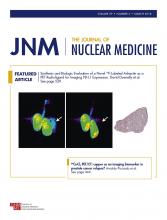TO THE EDITOR: Peptide receptor radionuclide therapy (PRRT) is highly effective in neuroendocrine tumors (NETs). In the NETTER-1 trial, progression-free survival at month 20 in patients with advanced midgut NET and treated with the somatostatin agonist 177Lu-DOTATATE was 65.2% (vs. 10.8% in the control group consisting in high dose cold somatostatin analogs) (1). Despite these striking results, we should strive to increase also the tumor response rates, as the objective response was only 18%. Somatostatin antagonist analogs such as 177Lu-DOTA-JR11 (OPS201; Octreopharm Sciences–Ipsen) may improve tumor response (2). In a small pilot study (4 patients with advanced NET), the absorbed doses in the tumors were approximately 3.5 times higher with 177Lu-DOTA-JR11 than with 177Lu-DOTATATE (2). The therapeutic index also favored 177Lu-DOTA-JR11: the median tumor–to–kidney dose ratio was 2.1 times higher and the tumor–to–bone marrow dose ratio was 2.6 times higher than with 177Lu-DOTATATE (2).
In a study on mice bearing tumor xenografts recently reported in The Journal of Nuclear Medicine, Nicolas and colleagues escalated the injected peptide mass of 177Lu-DOTA-JR11 from 10 to 200 pmol without finding any tumor saturation (3). By contrast, the uptake in somatostatin receptor–expressing organs was greatly suppressed, and consequently the tumor-to-background ratios were enhanced. According to the authors, because 200 pmol in mice would correspond to up to 1,300 μg in humans, the injected mass of antagonists should be higher than the levels currently used for agonists (≤50 μg for imaging and ≤200 μg for PRRT) (3).
It is our contention that extrapolating from mice to humans is not so straightforward, and injecting a greater mass for antagonist-based PRRT is not necessarily beneficial:
Although high doses of peptides reduced the physiologic uptake in the pancreas and stomach of mice (3), a human phase I/II trial showed that microdoses (15 or 50 μg) of the imaging compound 68Ga-NODAGA-JR11 (OPS202) were associated with a very low uptake in the pancreas and stomach and a moderate uptake in the liver—only the kidneys and spleen displayed high uptake (4). Also, in the human pilot study with 177Lu-DOTA-JR11 (∼150 μg peptide mass), the images recorded at 24 and 72 h showed low uptake in the pancreas and stomach, and the radiation dose to the pancreas and stomach wall were about 15 times lower than that to the kidneys (2). The biodistribution seems to be species-dependent: for example, differently from humans, pigs displayed a high uptake of 177Lu-DOTA-JR11 in the osteogenic bone, but the spleen was not visible (5).
Moreover, although increasing the injected mass of 177Lu-DOTA-JR11 in mice increased the tumor–to–bone marrow dose ratio, the tumor–to–kidney dose ratio decreased to a certain extent, and this may have undesired side effects during PRRT (3).
Increasing the amount of injected peptide might decrease the uptake of 177Lu-DOTA-JR11 in tumors that have low receptor density but may still be candidates for PRRT, such as non-NET tumors (6). It might also reduce the efficacy of hepatic intraarterial administrations, because the enhanced uptake in liver metastases with this approach relies on the “first pass effect” (7).
Tolerability is also an issue. Patients with metastatic NET are often treated with cold somatostatin agonist analogs in order to reduce secretory symptoms or halt tumor progression. This treatment is usually withheld before PRRT in order to avoid competition with radiolabeled peptides (1). The administration for PRRT of radiolabeled antagonists, rather than agonists, may induce or exacerbate symptoms, as shown, for example, in 1 of the 4 patients in the pilot study with 177Lu-DOTA-JR11 (150 μg), who experienced flush (2). Further increasing the amount of antagonist, to levels close to those known to elicit pharmacologic response with various hormonal secretions (8), may be risky, especially in patients with symptomatic NET. Rather, we should aim at injecting the lowest mass of peptide that yields a satisfactory tumor uptake and also explore the possibility of maintaining the treatment with cold somatostatin analogs during PRRT with somatostatin antagonists.
At difference with somatostatin receptors, when targeting other neuropeptide receptors, such as GRPR or NTR-1, the use of radiolabeled antagonists allows avoiding stimulation of these receptors and related symptoms (9).
In summary, given the interspecies variations in biodistribution, the optimal peptide mass to use for imaging or therapy with radiolabeled antagonists should be determined from human data, as previously done with agonists (10). Also, we think that the benefit from increasing the peptide mass of antagonist beyond the usual value of 150 μg (2) is still unproven.
Footnotes
Published online Oct. 6, 2017.
- © 2018 by the Society of Nuclear Medicine and Molecular Imaging.







